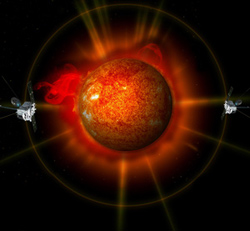 Scientists are now having their day in the Sun… a day that will last 8 years.
Scientists are now having their day in the Sun… a day that will last 8 years.
In October 2006, NASA launched a pair of twin spacecraft into space. Called STEREO – Solar TErrestrial RElations Observatory – they traveled in opposite directions, one ahead and the other behind the Earth in its orbit around the Sun. The goal was to get a wide, stereoscopic view of the Sun which would provide 3D information on our star.
Today they reached that goal. After traveling a combined 470 million kilometers (290 million miles) relative to the Earth, they are now on opposite sides of the Earth’s orbit, staring down at opposing faces of the Sun.
This image [click to ensolenate], taken just four days ago, is the result: the far side of the Sun! If you could bore straight through the center of the Sun in this image, plunging through nearly 1.4 million kilometers of solar fire, out the other side, and straight on for another 150 million kilometers, you’d be back at the Earth.
Mind you, the STEREO spacecraft reached their 180° separation today, and this image was taken just before that happened. The black line represent the small amount of solar real estate still invisible to the twin probes last week, but which can now be seen (I expect we’ll get that image from NASA pretty soon). The images are slightly fuzzy around that line because to the two spacecraft that’s the edge of the Sun where their view is distorted by perspective. However, that’s a minimal issue, and this is the first time we’ve ever seen the actual entire far side of the Sun!
I’ll note that there is no real, permanent far side of the Sun like there is for the Moon. The Moon spins once for every time it goes around the Earth, so it appears like the same face is always toward us. But the Sun rotates once about every 24.5 days. During that time, the Earth has moved 1/15th of the way around its orbit, so the Sun has to spin a little more to “catch up” with the Earth – another 1.7 days. So over the course of about a month we see the entire surface of the Sun.
But during that time it’s changing. The Sun is not a solid object; it’s a seething, writhing ball of plasma (ionized gas). Something might happen on the far side and it would take a week or more for it to rotate into view, and by then it will have evolved or possibly even disappeared entirely!
That’s no longer a problem. From their perches 1/4 of the way around the Sun each, STEREO will see anything that happens on the Sun’s far side, and scientists now have, for the first time, a 360° view of the entire solar surface. NASA has created a short video to explain all this:
Scientifically, this is critical for understanding the Sun. Events that happen anywhere on the Sun can have a ripple effect everywhere else… literally. A solar flare is a vast explosion on the Sun’s surface, releasing as much energy in a few minutes as millions or even billions of nuclear bombs. This sends gigantic seismic waves, ripples, across the Sun’s surface, affecting other regions. Gigantic coronal mass ejections (CMEs) are like hurricanes over the Sun, and the region causing one can extend onto the far side of the Sun where we can’t see it. Solar prominences and other features can be huge, stretching across the face of the Sun, again hiding part from view.
And, of course, in astronomy more is better. Having a better view, a better vantage point, just plain ol’ more data, is a big help. One thing astronomers have learned over the years is that new views provide new insights. Opening your eyes a little wider is always a good thing.
And this view will last for some time. The two spacecraft can’t suddenly stop and hover over the Sun; they are still moving around it, away from Earth. Eventually they’ll pass each other on the other side of the Sun, and start moving apart again, having swapped sides. However, we have the Solar Dynamics Observatory orbiting us here, providing a view of the near side of the Sun, so we’ll still have 360° solar coverage for the next eight years!
The Sun affects every aspect of life on Earth, from our light and heat to how flares and CMEs can potentially damage satellites and cause blackouts on the ground. We need to study this star, understand it. I want to know more just for the joy of learning, but in this case the science returned from missions like STEREO have a profound importance for all of us.
Image credits: NASA
Related posts:
- STEREO eclipse!
- STEREO McNaught
(gorgeous photo of a comet!)
- STEREO spots Jupiter slipping behind the Sun
- One piece of solar flare